Belarus to issue redenominated notes from 1 July 2016
 The National Bank of the Republic of Belarus has announced that president Aleksander Lukashenko has signed a decree for the redenomination of the national currency, the Belarusian ruble.
The National Bank of the Republic of Belarus has announced that president Aleksander Lukashenko has signed a decree for the redenomination of the national currency, the Belarusian ruble.
From the press release: "The redenomination will be carried out by means of substitution of the banknotes in circulation of the 2000 series by the banknotes and coins of the 2009 series in proportion of 10,000 Belarusian rubles of the 2000 series per 1 Belarusian ruble of the 2009 series. (...) A total of seven denominations of banknotes – 5, 10, 20, 50, 100, 200, and 500 rubles – and eight denominations of coins – 1, 2, 5, 10, 20, and 50 copecks, and 1 and 2 rubles – will be put into circulation beginning on July 1, 2016.
The general concept of the new banknotes design meets the motto "Belarus is my country". Each banknote is dedicated to one of the regions of Belarus and the city of Minsk. The coincidence of the regions and the banknotes denominations was determined in alphabetical order. The design of the banknote of 5 ruble denomination is dedicated to Brest region, 10 rubles – to Vitebsk region, 20 rubles – to Gomel region, 50 rubles – to Grodno region, 100 rubles – to Minsk region, 200 rubles – to Mogilev region, and 500 rubles – to the city of Minsk. The design of new banknotes of the 2009 series maintains continuity of the line of banknotes of the 2000 series as to the use of images of the architectural and urban monuments.
The currently circulating banknotes of the 2000 series will be the sole legal tender for making cash settlements in the Republic of Belarus till July 1, 2016.
From July 1, 2016 to December 31, 2016, the banknotes of the 2000 series and the banknotes and coins of the 2009 series will be in parallel circulation and subject to obligatory acceptance without restriction in all kinds of payments performed by all economic entities.
During the next five years – from January 1, 2017 through December 31, 2021 – the currency units of the 2000 series will be exchanged for the currency units of the 2009 series in any sum without restriction and charging commission.
It is worth mentioning that preparations for the redenomination in the Republic of Belarus were under way during a fairly long period. For example, new currency units that will be put into circulation beginning on July 1, 2016 have been printed by order of the National Bank of the Republic of Belarus as early as 2008. However, at that time the redenomination was postponed due to the global economic crisis and, as a consequence, deteriorating economic situation in our country, whereas printed currency units were transferred to the National Bank’s Central Vault.
Taking into account the time of printing, new Belarusian rubles feature certain peculiarities. In particular, banknotes of 2009 series that are put into circulation bear the facsimile of Petr P. Prokopovich’s signature, the then Chairman of the Board of the National Bank. Also, the new fifty-ruble note carries an inscription which is inconsistent with currently applicable Belarusian spelling rules. (...)
The above-mentioned inconsistencies will be removed as the National Bank will place further orders to print new banknotes."
The banknotes and coins that will be put into circulation. (pdf)
This is the third redenomination in Belarus. The Belarusian ruble was redenominated on 20 August 1994, with one new unit equaling 10 old ones, and the second time it lost three zeros on 1 January 2000. As some may recall in 2014 there was a mention of the redenominated banknotes looking a lot like euro banknotes. Well, I don't know about you but the 5-ruble note for instance does look an awful lot like the new 10-euro note, doens't it? And the 10-ruble looks a bit like like the new 20-euro note, right?
Below are the new banknotes in all their glory:
5 ruble. Front: Belaya Vezha (the Tower of Kamenets) in the town of Kamenets, Brest Region. Back: the collage devoted to first Slavic settlements (a leather belt fragment, a wooden wheel, and a picture of "Berestie" ancient stronghold).
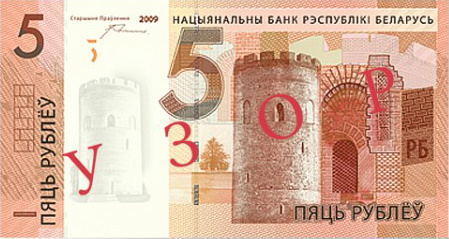
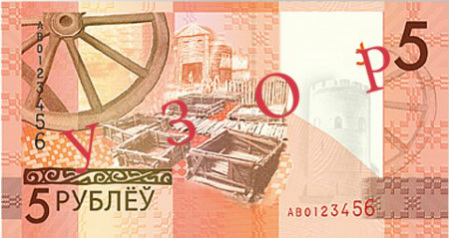
10 ruble. Front: the church of the Savior and Transfiguration in the town of Polotsk, Vitebsk Region. Back: the collage devoted to enlightenment and printing (books, the Cross of Euphrosyne of Polotsk, and an ornamental pattern fragment).
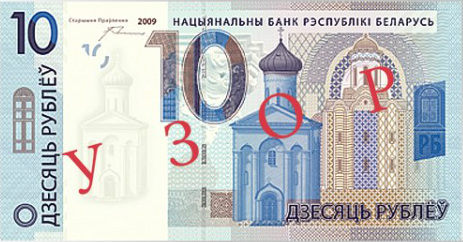

20 ruble. Front: The Rumyantsev-Paskevich palace in the town of Gomel. Back: the collage devoted to spirituality (a bell, the Turov Gospel, ancient town of Turov, and fragments of carving).
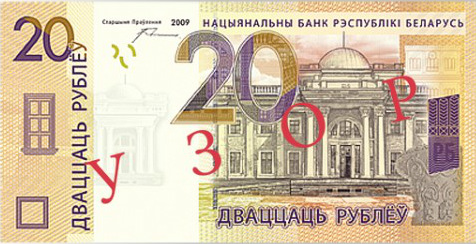
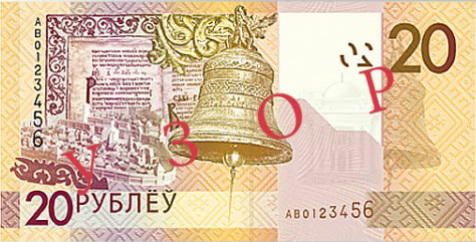
50 ruble. Front: the Castle of Mir in the settlement of Mir, Grodno Region. Back: the collage devoted to art (a lyre and laurel twigs, a quill pen, a sheet of paper, and a stave).
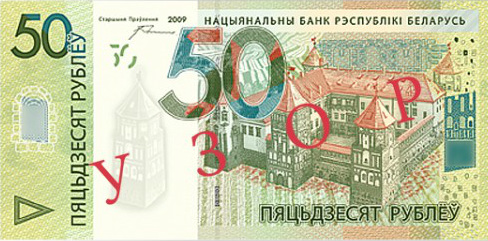
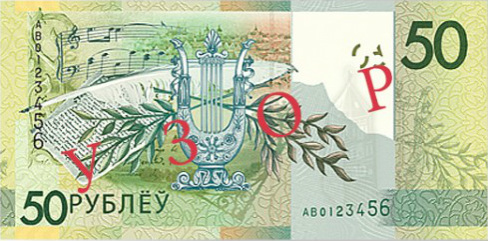
100 ruble. Front: the Radziwills' castle in the town of Nesvizh, Minsk Region. Back: the collage devoted to the theatre and folk festivals (a violin, a tambourine, a zhaleyka woodwind instrument , the belts of Slutsk , and the symbols of folk festivals such as the "Kalyady's star", a she-goat, and "Batleyka" folk puppet theatre).
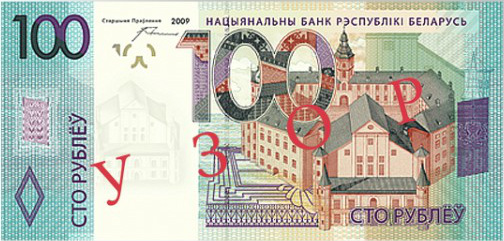
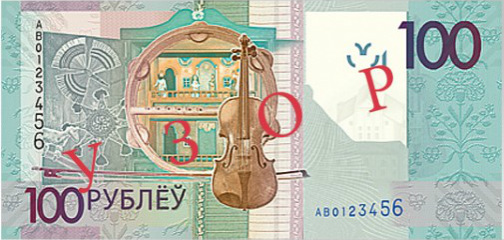
200 ruble. Front: Mogilev Regional Art Museum named after P. Maslennikov, in the town of Mogilev. Back: the collage devoted to handicraft and urban construction (the golden key and the seal of the town of Mogilev, a glazed tile (a stove tile), and fragments of the wrought iron lattice)
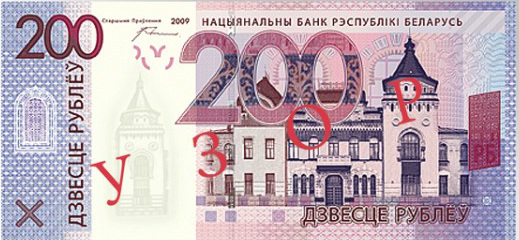
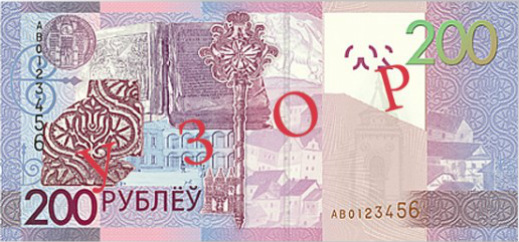
500 ruble. Front: National Library of the Republic of Belarus in the city of Minsk. Back: the collage devoted to literature (a quill pen, an inkwell, book covers, and a fern leaf
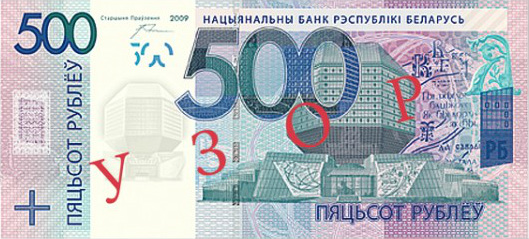
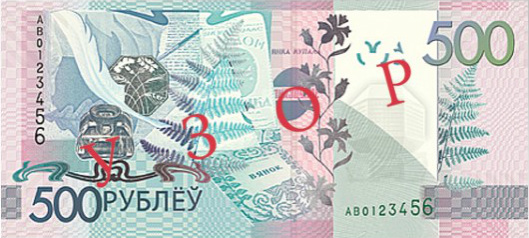
Thanks to Triaff Nikitin for the tip!






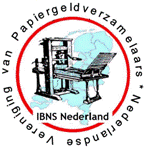


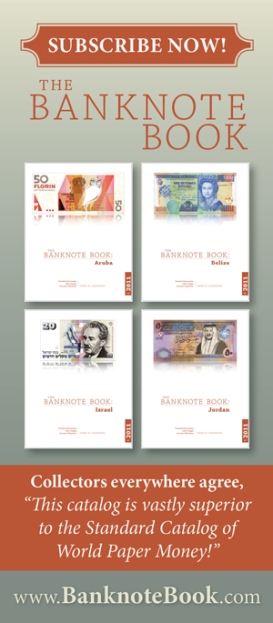
No comments